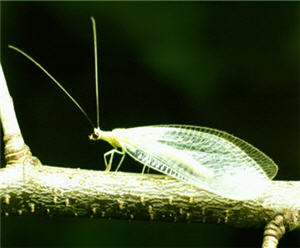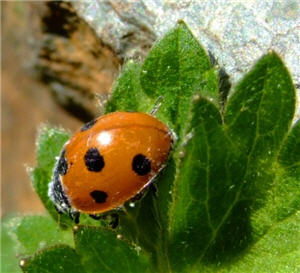- TABLE OF CONTENTS
- DESIGN
- Introduction to Design
- Active Family
- Empty Nesters
- Young Professionals
- Questionnaire
- Principles of Design
- Design Concepts
- Working With Professionals
- Drainage
- Soil
- Climate/Weather
- Safety
- Landscape & Irrigation Plans
- Landscape Design
- Installing the Garden
- Hydrozoning
- Public and Demonstration Gardens
- Xeriscape
- Garden Care
- Composting
- Lawn
- Maintaining Your Garden
- Plant Water Needs
- Mulch
- Pest Management
- Growing a Healthy Garden
- Reading a Pesticide Label
- Pruning Landscape Plants
- Planting Instructions
- IRRIGATION
- Irrigation 101
- Types of Irrigation Systems
- Upgrading Existing System
- Choosing an Irrigation Control System
- Irrigation, Maintenance and Troubleshooting
- Eliminating Run-off and Overspray
- Acknowledgments
Pests
Many gardeners automatically reach for chemical-based pesticides to kill garden pests. For the short term, these chemicals are effective. However, for the long-term ecological health of your garden, these agents are detrimental. Over time, they destroy not only the harmful insects and bacteria but also the ones that are beneficial to the garden. This increases the garden’s vulnerability. A major concern of pesticide use is that it can contaminate surface water by washing into creeks and rivers. Pesticides may also percolate into groundwater contaminating those water sources as well.
Integrated Pest Management System
Integrated Pest Management (IPM) is a pest control strategy that focuses on long-term prevention or suppression of pest problems with minimum impact on human health, the environment, and non-target organisms. Before taking any pest control action, IPM first sets an action threshold, a point at which pest populations or environmental conditions indicate that pest control actions must be taken. Sighting a single pest does not always mean that control is needed. Preferred pest management techniques include proper identification of the pest, encouraging naturally occurring biological control, using alternate plant species or varieties that resist pests, selecting pesticides with a lower toxicity to humans or non-target organisms, adopting cultivation, pruning, fertilizing, or irrigation practices that reduce pest problems, and changing the habitat to make it incompatible with pest development. Pesticides are used as a last resort when careful monitoring indicates the need. When treatments are necessary, the least toxic and most target-specific pesticides are chosen. Consider the signal words on the label: persistence, impact on non-targets, and potential chronic human health effects. Check the pesticide label to make sure all precautions and legal requirements are being carefully adhered to, and verify that the person doing the application is certified and qualified to handle the equipment and the material chosen. Contractors differ in their skills and experience, and it is important to hire a company that is reliable and knowledgeable about IPM practices.
Remember that IPM is a sensible and thoughtful approach to pest control, combining the use of physical, cultural, biological, mechanical, and chemical control methods to effectively manage pests with minimal risk to humans and the environment.
Preventative Measures
| • | Select plant varieties resistant to diseases and pests that are prevalent in your area. |
| • | Plant appropriately and follow up with appropriate watering and fertilizing schedules, and garden cleanup. |
| • | Rotate crops to prevent the buildup of specific pests in a vegetable garden or annual color bed. |
| • | Check your plants frequently. Look for signs of infestation such as fungal growth, holes in leaves or fruit, sap oozing from the bark, or wilted branches. Check for insects hiding on leaf undersides, in bark tissues, or beneath fallen leaves. |
Hands-on, non-toxic methods:
| • | Remove and destroy slugs, snails, caterpillars, and other pests by hand or with traps. You may need to pluck and destroy entire leaves. |
| • | Prune and destroy branches infested with pests or disease. |
| • | A jet of water from a garden hose nozzle can knock sucking pests from plants and often kill them (aphids). |
| • | Certain physical structures used as barriers can prevent pests from reaching plants. These include row covers, plant cages, copper band and plant collars (paper cups, plastic cartons, or empty cans with the ends cut out) that protect seedlings from cutworms and other insects. |
| • | You can trap pests with insect specific pheromone traps (pheromones are chemicals used by insects for attraction). |
Biological Controls
Biological controls (beneficial insects) are living organisms used to destroy garden pests. This type of control occurs naturally in the garden all the time. To draw beneficial insects into your garden and encourage them to remain:
Lacewing Source: Clemson University Department of Entomology |
Lady Bug |
| • | Provide a food source and avoid chemical sprays that will destroy useful creatures. |
| • | Purchase and release beneficial insects such as ladybugs and lacewings. Keep in mind that they will only remain as long as a food source is present. |
| • | Create a naturally pest resistant garden For IPM information visit the UC Davis IPM Online http://www.ipm.ucdavis.edu/PDF/PESTNOTES/index.html |
| • | Fresno UC Cooperative Extension Office 1720 South Maple Avenue Fresno, CA 93702-4516 (559) 456-7285 Click here for Master Gardeners of Fresno County local pest management resources. |
For IPM information, click the pest in question:
NOTE: Information that includes the use of beneficial insects and other animals (bats, humming birds) as controls can be found here:
http://www.ipm.ucdavis.edu/PMG/PESTNOTES/pn74140.html
Chemical Controls
Keep in mind that the truly pest-free garden does not exist. At times, pesticides need to be used but should be considered only as a last resort. If you do use pesticides, you must be careful with their use and disposal:
| • | Study Reading a Pesticide Label to learn how to read a pesticide label. |
| • | The signal words "CAUTION," "WARNING," and "DANGER" (in order of increasing toxicity) indicate the relative acute toxicity, or short-term effects, of the active ingredients to humans. They do not refer to long-term effects to humans nor do they indicate the effect on aquatic invertebrates. |
| • | Always dispose of pesticides, fungicides, and herbicides according to the product directions. Never pour pesticide down any type of drain, including a storm drain; it pollutes the water supply and harms our environment. |
Click here for more information on disposal, and visit the EPA website:http://www.epa.gov/opp00001/regulating/disposal.htm

